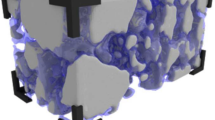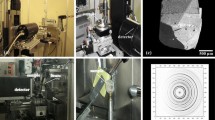Abstract
The application of synchrotron radiation X-ray computed micro-tomography (SR X-μCT) as a non-invasive approach to the microstructural investigation of Portland cement binders during hydration is presented. The two- and three-dimensional µm-scale imaging of undisturbed samples at hydration ages from ~1.5 h to 3 days is used to obtain a direct visualization of the spatial and temporal relationships between different cement paste components. The microstructural evolution of two cementitious systems during the early stages of hydration is successfully monitored from the comparison of tomographic slices and volumes, clearly showing the progressive growth of hydration phases; the changes in the amount of porosity and unreacted clinker are also quantified. Some critical issues related to the experimental setup and data processing are addressed and discussed as well. Furthermore, a simple procedure to estimate the mean X-ray absorption coefficient of cement pastes from X-ray radiographs is illustrated. The results confirm the potentialities of synchrotron-based X-ray computed micro-tomography for the three-dimensional investigation of µm-scale modifications in hydrating cement pastes with an adequate time resolution, thus providing a real in-situ monitoring of the microstructural evolution of such complex materials.








Similar content being viewed by others
References
Scrivener KL (2004) Backscattered electron imaging of cementitious microstructures: understanding and quantification. Cem Concr Compos 26(8):935–945
Stutzman P (2004) Scanning electron microscopy imaging of hydraulic cement microstructure. Cem Concr Compos 26(8):957–966
Walsh D, Otooni MA, Taylor ME Jr, Marcinkowski MJ (1974) Study of Portland cement fracture surfaces by scanning electron microscopy techniques. J Mater Sci 9:423–429. doi:10.1007/BF00737842
Kak AC, Slaney M (1988) Principles of computerized tomographic imaging. IEEE Press, New York
Bentz DP, Quenard DA, Kunzel HM, Baruchel J, Peyrin F, Martys NS, Garboczi EJ (2000) Microstructure and transport properties of porous building materials. II: three-dimensional X-ray tomographic studies. Mater Struct 33:147–153
Landis EN, Petrell AL, Lu S, Nagy EN (2000) Examination of pore structure using three-dimensional image analysis of microtomographic data. Concr Sci Eng 2:162–169
Bentz DP, Mizell S, Satterfield S, Devaney J, George W, Ketcham P, Graham J, Porterfield J, Quenard D, Vallee F, Sallee H, Boller E, Baruchel J (2002) The visible cement data set. J Res Natl Inst Stand Technol 107:137–148
Helfen L, Dehn F, Mikulík P, Baumbach T (2005) Three-dimensional imaging of cement microstructure evolution during hydration. Adv Cem Res 17(3):103–111
Burlion N, Bernard D, Chen D (2006) X-ray microtomography: application to microstructure analysis of a cementitious material during leaching process. Cem Concr Res 36:346–357
Gallucci E, Scrivener K, Groso A, Stampanoni M, Margaritondo G (2007) 3D experimental investigation of the microstructure of cements pastes using synchrotron X-ray microtomography (μCT). Cem Concr Res 37:360–368
Promentilla MAB, Sugiyama T, Hitomi T, Takeda N (2009) Quantification of tortuosity in hardened cement pastes using synchrotron-based X-ray computed microtomography. Cem Concr Res 39(6):548–557
Gastaldi D, Canonico F, Capelli L, Boccaleri E, Milanesio M, Palin L, Croce G, Marone F, Mader K, Stampanoni M (2012) In situ tomographic investigation on the early hydration behaviors of cementing systems. Constr Build Mat 29:284–290
Stock SR, De Carlo F, Almer JD (2008) High energy X-ray scattering tomography applied to bone. J Struct Biol 161:144–150
Bleuet P, Welcomme E, Dooryhée E, Susini J, Hodeau J-L, Walter P (2008) Probing the structure of heterogeneous diluted materials by diffraction tomography. Nat Mater 7:468–472
Artioli G, Cerulli T, Cruciani G, Dalconi MC, Ferrari G, Parisatto M, Rack A, Tucoulou R (2010) X-ray diffraction microtomography (XRD-CT), a novel tool for non-invasive mapping of phase development in cement materials. Anal Bioanal Chem 397(6):2131–2136
Valentini L, Dalconi MC, Parisatto M, Cruciani G, Artioli G (2011) Towards three-dimensional quantitative reconstruction of cement microstructure by X-ray diffraction microtomography. J Appl Crystallogr 44(2):272–280
Voltolini M, Dalconi MC, Artioli G, Parisatto M, Valentini L, Russo V, Bonnin A, Tucoulou R (2013) Understanding cement hydration at the microscale: new opportunities from ‘pencil-beam’ synchrotron X-ray diffraction tomography. J Appl Crystallogr 46(1):142–152
Kantro DL (1980) Influence of water-reducing admixtures on properties of cement paste—a miniature slump test. Cem Concr Aggreg 2:95–102
Martinez-Criado G, Tucoulou R, Cloetens P, Bleuet P, Bohic S, Cauzid J, Kieffer I, Kosior E, Laboure S, Petitgirard S, Rack A, Angel Sans J, Segura-Ruiz J, Suhonen H, Susini J, Villanova J (2012) Status of the hard X-ray microprobe beamline ID22 of the European Synchrotron Radiation Facility. J Synchrotron Radiat 19(1):10–18
Jennings RJ (1988) A method for comparing beam-hardening filter materials for diagnostic radiology. Med Phys 15:588–599
Haibel A (2008) Synchrotron X-ray absorption tomography. In: Banhart J (ed) Advanced tomographic methods in materials research and engineering. Oxford University Press, New York, pp 141–160
Brooks RA, Di Chiro G (1976) Beam hardening in X-ray reconstructive tomography. Phys Med Biol 21:390–398
Snigirev A, Snigireva I, Kohn V, Kuznetsov S, Schelokov I (1995) On the possibilities of X-ray phase contrast microimaging by coherent high-energy synchrotron radiation. Rev Sci Instrum 66:5486–5492
Raven C, Snigirev A, Snigireva I, Spanne P, Souvorov A, Kohn V (1996) Phase-contrast microtomography with coherent high-energy synchrotron X-rays. Appl Phys Lett 69:1826–1828
Cloetens P, Ludwig W, Baruchel J, Guigay J-P, Rejmankova-Pernot P, Salomé-Pateyron M, Schlenker M, Buffière JY, Maire E, Peix G (1999) Hard X-ray phase imaging using simple propagation of a coherent synchrotron radiation beam. J Phys D 32:A145–A151
Labiche J-C, Mathon O, Pascarelli S, Newton MA, Guilera Ferre G, Curfs C, Vaughan G, Homs A, Fernandez Carreiras D (2007) The fast readout low noise camera as a versatile x-ray detector for time resolved dispersive extended X-ray absorption fine structure and diffraction studies of dynamic problems in materials science, chemistry, and catalysis. Rev Sci Instrum 78:091301
Koch A, Peyrin F, Heurtier P, Ferrand B, Chambaz B, Ludwig W, Couchaud M (1999) X-ray camera for computed microtomography of biological samples with micrometer resolution using Lu3Al5O12 and Y3Al5O12 scintillators. SPIE Conference on Physics of Medical Imaging, San Diego 3659:170–179
Mirone A, Wilcke R, Hammersley A, Ferrero C (2012) PyHST (High Speed Tomographic Reconstruction), http://www.esrf.eu/UsersAndScience/Experiments/TBS/SciSoft/
Mirone A, Brun E, Gouillart E, Tafforeau P, Kieffer J (2014) The PyHST2 hybrid distributed code for high speed tomographic reconstruction with iterative reconstruction and a priori knowledge capabilities. Nucl Instr Meth Phys Res B 324:41–48
Henke BL, Gullikson EM, Davis JC (1993) X-ray interactions: photoabsorption, scattering, transmission, and reflection at E = 50-30000 eV, Z = 1-92, At Data Nucl Data Tables 54(2):181–342 (http://henke.lbl.gov/optical_constants/)
Bentz DP, Coveney PV, Garboczi EJ, Kleyn MF, Stutzman PE (1994) Cellular automaton simulations of cement hydration and microstructure development. Model Simul Mater Sci Eng 2:783–808
Cloetens P, Ludwig W, Baruchel J, Van Dyck D, Van Landuyt J, Guigay J-P, Schlenker M (1999) Holotomography: quantitative phase tomography with micrometer resolution using hard synchrotron radiation X-rays. Appl Phys Lett 75:2912–2914
Weitkamp T, Haas D, Wegrzynek D, Rack A (2011) ANKAphase: software for single-distance phase-retrieval from inline X-ray phase contrast radiographs. J Synchrotron Radiat 18:617–629
Langer M, Cloetens P, Guigay J-P, Peyrin F (2008) Quantitative comparison of direct phase retrieval algorithms in in-line phase tomography. Med Phys 35(10):4556–4566
Zabler S, Riesemeier H, Fratzl P, Zaslansky P (2006) Fresnel-propagated imaging for the study of human tooth dentin by partially coherent X-ray tomography. Opt Expr 14(19):8584–8597
Hubbell JH, Seltzer SM (1996) Tables of X-ray mass attenuation coefficients and mass energy-absorption coefficients from 1 keV to 20 MeV for elements Z = 1 to 92 and 48 additional substances of dosimetric interest, http://www.nist.gov/pml/data/xraycoef/index.cfm
Rack A, Garcia-Moreno F, Schmitt C, Betz O, Cecilia A, Ershov A, Rack T, Banhart J, Zabler S (2010) On the possibilities of hard X-ray imaging with high spatio-temporal resolution using polychromatic synchrotron radiation. J X-ray Sci Technol 18(4):429–441
Acknowledgements
This work was supported by the European Synchrotron Radiation Facility (exp. MA-648, MA-1063). The experiments were performed in the frame of the research agreement between Mapei S.p.A. and the Department of Geosciences of the University of Padua. The authors would like to acknowledge Cyril Guilloud and Sylvain Laboure (ESRF) for their precious help during the experiments at ID22.
Author information
Authors and Affiliations
Corresponding author
Rights and permissions
About this article
Cite this article
Parisatto, M., Dalconi, M.C., Valentini, L. et al. Examining microstructural evolution of Portland cements by in-situ synchrotron micro-tomography. J Mater Sci 50, 1805–1817 (2015). https://doi.org/10.1007/s10853-014-8743-9
Received:
Accepted:
Published:
Issue Date:
DOI: https://doi.org/10.1007/s10853-014-8743-9




